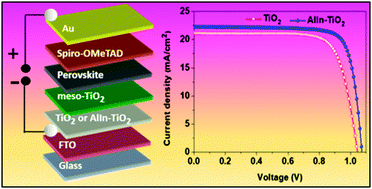Improved photovoltaic performance of triple-cation mixed-halide perovskite solar cells with binary trivalent metals incorporated into the titanium dioxide electron transport layer†
Abstract
Among the next-generation photovoltaic technologies, perovskite solar cells have attracted significant attention and interest. In addition to the perovskite absorber component, the adjacent layers within the stack play decisive roles in the stability and overall power conversion efficiency (PCE) of a device. In this study, we demonstrated the use of a solution-processed aluminium indium (AlIn)-TiO2 compact layer as a highly effective electron transport layer (ETL) to achieve outstanding performance of perovskite solar cells; our results showed that the incorporation of AlIn into the TiO2 layer allowed better energy band alignment of the ETL-perovskite interface, improved the transparency, and enhanced the conductivity as compared to the case of pristine TiO2. Via co-doping these trivalent metals, an enhancement in voltage, current density, and even fill factor was observed. In addition, the results obtained from electrochemical impedance spectroscopy (EIS) revealed that the AlIn-TiO2-based device exhibited larger recombination resistance, which significantly benefited the performance of the devices. As a result, the optimized AlIn-TiO2 ETL device attained the surpassing PCE of 19% as compared to the pristine TiO2 solar device having the PCE of 16.67%.



 Please wait while we load your content...
Please wait while we load your content...